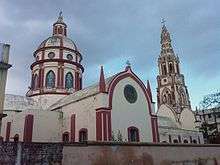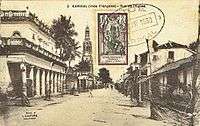Our Lady of Angels Church, Karaikal
| Our Lady of Angels Church | |
|---|---|
 Front view of the church | |
 Our Lady of Angels Church | |
| 10°55′01″N 79°50′03″E / 10.91694°N 79.83417°E | |
| Location | Karaikal |
| Country | India |
| Denomination | Catholic |
| History | |
| Founded | 1828 |
| Architecture | |
| Status | Parish church |
| Functional status | Active |
| Architectural type | Chapel |
| Style | Neo-Gothic architecture |
| Administration | |
| Archdiocese | Independent diocese |
Our Lady of Angels Church (also called Karaikal Church) is the oldest church in Karaikal in Pondicherry, a Union territory in South India. The original structure was built in Neo-Gothic architecture by the French Colonial Empire in 1822. The original structure is believed to have been built during 1739 and was destroyed by the British. The church has the tallest structure for any building in Karaikal, raising to a height of 133 ft (41 m), built during 1891.
Our Lady of Angels Church is a working church with hourly prayer and daily services and follows Roman Catholic sect of Christianity. The Thetheravu Matha festival is a ten-day festival celebrated in the Church every year on 15 August when the festive image of Mary is taken in a chariot around the streets of the Church. The Church is one of the most prominent landmarks in Karaikal and faces the Bay of Bengal.
Architecture
The Church is located in Church street in Karaikal, which is believed to be named after the Church. The church is built in Neo-Gothic architecture with the main chappel, a 133 ft (41 m) tower approached through a structure with doom shaped roof and a worship hall. The top of the tower is a cone with an octagonal base and the cone houses three clocks.[1] There are five huge bells, the sound of which can be heard as far as 5 km (3.1 mi) from its location. The Church has stained glass windows and marble altars, believed to have been added during 1739. The shrine faces the East facing the sea towards Bay of Bengal. The altar is originally believed to have a statue of Our Lady of Angels, but houses a Holy Cross in modern times.[2]
History

Karaikal was bought as a colony by the French in 1750. It changed hands between British and the French like Pondicherry.[2] The French surrendered the town to the British in 1761 and once more subsequently. The Church was built by the French during 1739 and the original structure was believed to have been built during 1739, which was destroyed by the British. When Karaikal came to the hands of the French completely by 1816 after the Treaty of Paris, the Church was rebuilt in 1828.[3][4] While the original structure was built during 1822, the tower was erected during 1891.[1]
Culture
Our Lady of Angels Church has the tallest structure in Karaikal and is one of the most prominent landmarks in the town.[5] The Church is locally called Thetheravu Matha Kovil, meaning the "temple of the mother who pacifies".[2] The church is a working church with hourly prayer and daily services and follows Roman Catholic sect of Christianity. The priests in the church were originally only French, but during modern times, Tamil people were also allowed. During 15 August every year, the Thetheravu Matha festival is celebrated in the Church, with a flag hoisting on 6 August. During the festival, the festival image of Mary is taking round the streets of Karaikal in a chariot. The event is one of the most prominent festival in the region.[2] Vannan is one of the Dalit communities who embraced the Church and Christianity in large numbers during the earlier part of the 19th century. Many of them and their families visited France and were socially and economically uplifted on account of education offered to the community by the Church.[6]
References
- 1 2 Michell, George (2013). Southern India: A Guide to Monuments Sites & Museums. Roli Books Private Limited. ISBN 9788174369031.
- 1 2 3 4 "Our lady of Angel's church". Government of Puducherry. 2011. Retrieved 25 November 2015.
- ↑ P., Raja; Keshari, Rita Nath (2005). Glimpses of Pondicherry. Busy Bee Books. ISBN 9788187619093.
- ↑ Srinivasa, Kavita (1 November 2012). "Beaches and blessings". Business Line. Retrieved 25 November 2015.
- ↑ "Plan to augment Karaikal power plant capacity". Karaikal: The Hindu. 26 July 2004. Retrieved 25 November 2015.
- ↑ Singh, Nagendra Kr. (2006). Global Encyclopaedia of the South Indian Dalit's Ethnography, Volume 1. Global Vision Pub House. p. 819=822. ISBN 9788182201682.